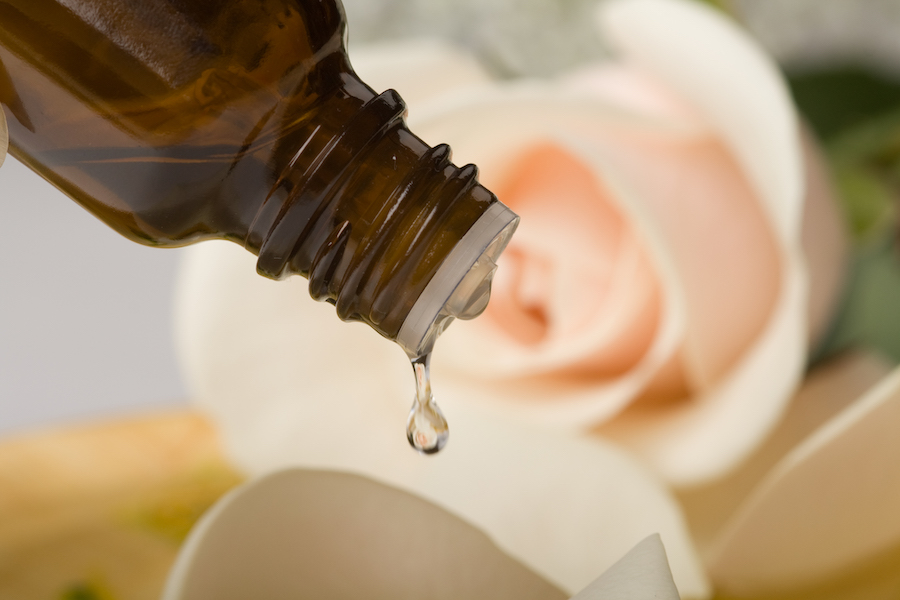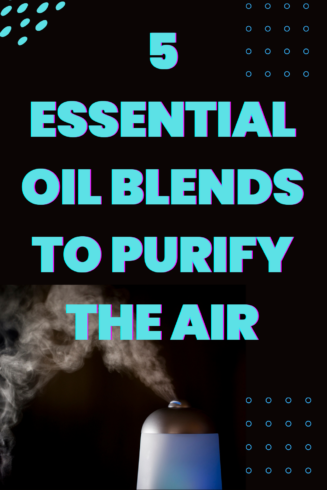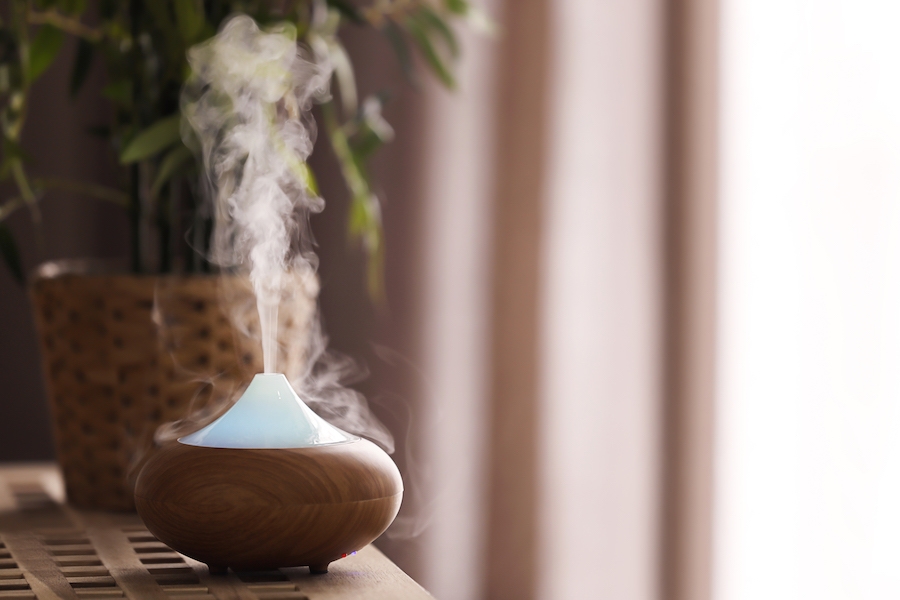Essential oils can be used to kill bacteria, mold, and odors caused by those microbes.
It’s important that you use them in very specific ways otherwise you could be wasting the oils, hurting your air filters, or hurting yourself.
When companies claim that their essential oils purify the air, they do this only in very specific ways and under specific circumstances. So let’s take a look at which oils to use and how to use them effectively.
This article contains affiliate links, upon purchase I make a small commission at not extra cost to you.

Essential Oils That Are Anti-Bacterial and Anti-Fungal
1. Fir Oil
Antibacterial activity was shown by the essential oil of silver fir against Escherichia coli, methicillin-sensitive Staphylococcus aureus, and Pseudomonas aeruginosa. Silver fir essential oil was found to be active against Klebsiella pneumoniae while Siberian fir essential oil showed mild activity against Pseudomonas aeruginosa and methicillin-sensitive Staphylococcus aureus (Source).
Essential oil from Pinus sibirica (Siberian pine) and Аbies sibirica (Siberian fir) are effective against Escherichia coli, Klebsiella pneumoniae, Staphylococcus aureus 209р, Micrococcus luteus, Acinetobacter baumanii, and Candida albicans (source).
Similar: Pine oil, Cyprus oil, and Juniper oil are also effective against bacteria (source, source & source)
2. Lemon Oil
Citrus limon (lemon) essential oil showed inhibitory anti-fungal activity against Aspergillus flavus, Fusarium spp., Aspergillus niger (source), Aspergillus parasiticus, Cladosporium cladosporioides, Eurotium herbariorum, Penicillium chrysogenum, Aspergillus carbonarius (source) and Penicillium verrucosum (source).
Similar: Other citrus oils like mandarin (Citrus reticulata L.), grapefruit (Citrus paradisi L.) and orange (Citrus sinensis L.) showed anti-fungal activity against the molds Aspergillus niger, Aspergillus flavus, Penicillium chrysogenum and Penicillium verrucosum (source).
3. Black Cumin Seed Oil
The essential oil prepared from the seeds of Nigella sativa L exhibited strong deodorizing activity against methyl mercaptan, which is a main factor in oral malodor (source).
Nigella sativa L also has anti-bacterial properties (source).
4. Cinnamon Oil
Cinnamon oil proved to be a potent fungitoxicant against: Aspergillus niger, Aspergillus fumigatus, Aspergillus nidulans, Aspergillus flavus, Candida albicans, Candida tropicalis, Candida pseudotropicalis (Candida kefyr), Histoplasma capsulatum (source), Coriolus versicolor, Laetiporus sulphureus (Source), Eurotium spp., Aspergillus spp., Penicillium spp. (source), and Botrytis cinerea (source).
Cinnamon oil also has anti-bacterial properties (source).
5. Rosemary Oil
Rosemary essential oil exhibited anti-fungal activity against Eurotium spp., Aspergillus spp., and Penicillium spp. (source). Other studies show Rosemary’s anti-fungal activity (source). It also displays anti-bacterial activity (source).
6. Clove Oil
Clove essential oil exhibited anti-fungal activity against Eurotium spp., Aspergillus spp., Penicillium spp (Source), and Botrytis cinerea (source).
7. Tea Tree Oil
Tea Tree oil has anti-bacterial properties (source).
8. Copaiba Oil
Copaiba oil displays anti-microbial action against bacteria and fungi, such as Streptococcus spp, Staphylococcus spp, Pseudomonas spp, Paenibacillus spp, P. gingivalis, Candida spp, Escherichia coli (source and source), Candida parapsilosis, Aspergillus flavus, and A tamarii (source).
*Please note that spp means multiple species.
Essential Oil Blends That are Anti-Microbial
For Bacterial Odors:
Deodorizing by Plant Therapy – Palmarosa, Lemon, Patchouli, Coriander, Grapefruit Pink, Cypress, Bergamot, Tea Tree.
Purify by doTerra – Lemon Peel, Siberian Fir Needle, Citronella Grass, Lime Peel, Tea Tree Leaf, Cilantro Herb.
For Mold:
Germ Fighter by Plant Therapy – Cinnamon Cassia, Lemon, Eucalyptus, Clove, Rosemary.
On Guard by doTerra – Wild Orange Peel, Clove Bud, Cinnamon Leaf, Cinnamon Bark, Eucalyptus Leaf, and Rosemary Leaf/Flower.
Thieves Oil by Young Living – Clove bud oil, Lemon peel oil, Cinnamon bark oil, Eucalyptus leaf oil, Rosemary leaf oil.

Adding Essential Oils to an Air Purifier
The only type of air purifier that you can add essential oils to is an air purifier with a humidifying component. The Dyson Pure Humidify+Cool PH01 and the SHARP Air Purifier And Humidifier With Plasmacluster are two examples.
I would not recommend these for use with essential oils because you are employing contradictory functions simultaneously. The essential oils produce VOCs and fine particulates and so by using them so close together and at the same time you are stressing your HEPA filter and your VOC filter, and you are diminishing the effects of the essential oils.
If you want to use essential oils for their deodorizing, anti-bacterial, and anti-fungal effects, use them physically apart from, and at a different time from your other air purifying technologies like HEPA and carbon.
I would recommend diffusing or nebulizing essential oils to clean the air with one caveat…

Diffusing/Fogging Essential Oils to Purify the Air
Diffusing/nebulizing essential oils is the best way to deploy them to kill bacteria or mold spores. I would do this when people and pets are out of the room because diffusing creates high levels of VOCs and PM2.5 particulates (more on that in the section below).
Fogging to Kill Bacteria and Deodorize
If you want to kill bacterial odors in a room I would diffuse or nebulise the essential oils on a timer of 1 to 2 hours in most cases while you are out of the room. You can certainly do longer if the odor persists.
If you have indoor humidity that is on the higher side I would not use a diffuser but a waterless nebulizer instead. This waterless nebulizer has a customizable time, and this waterless nebulizer can run on a two-hour minimum timer.
Humidity could also add to the source of bacteria, depending on what the cause is.
If you have low humidity you could use a Diffuser with a timer (that uses some water), that one has a 1-hour minimum.
Fogging to Kill Mold Spores
Dr. Edward R. Close, PhD in Environmental Engineering, diffused Thieves Oil blend (a blend of Clove (Syzygium aromaticum) bud oil, Lemon (Citrus limon) peel oil, Cinnamon (Cinnamomum verum) bark oil, Eucalyptus (Eucalyptus radiata) leaf oil, and Rosemary (Rosmarinus officinalis) leaf oil) in the Aroma-Ace Atomizing Diffuser in homes for a 24-hour period.
(You could also use the mix by Plant Therapy, which is made with the same oils but is less expensive).
Dr. Close and his wife, Jacquelyn Close, discovered that diffusing essential oils with a waterless cold air nebulizer was the best solution to address mold spores in buildings. The results of their case studies showed a huge reduction in mold spores and it had a residual effect (i.e. the spores did not come back quickly).
His research showed that the essential oils digest the mold spores that they come in contact with and don’t leave dead mold spores behind.
NOTE! If you have mold growing in the wall this does not address that underlying problem and the mycotoxins and mold VOCs being produced. Putting a bandaid on the situation could cause a false sense of security.
They recommend that you place one diffuser in each room (one for every 1000 sq ft) and diffuse continuously for a minimum of 24 hours. How long you have to diffuse (24-48 hours or longer) is determined by air sampling or tape-lift sampling. Use a glass plate under the diffuser to protect surfaces from the oil.
This book by Dr Close and his wife goes into more detail.
If you prefer to watch a seminar about Dr Close’s methods, this masterclass will be helpful. He is talking with mold-preventative architect Cheryl Ciecko. The other classes in the series will also be helpful in making sure you properly identify the source of the mold and safely clean mold (as you could do a lot of harm cleaning it yourself). Don’t just put a bandaid over it!
Essential Oils Increase VOCs
Primary VOCs
Diffusing essential oils increases VOCs. In one study each essential oil emitted between 20-140 VOCs. The most prevalent VOCs were: alpha-pinene, Limonene, Acetone, Linalool, alpha-phellandrene, beta-myrcene, Camphene, Ethanol, beta-pinene, 3-carene, Eucalyptol, Acetaldehyde, Beta-phellandrene, Gamma-terpinene, M-cymene, beta-trans-ocimene, Methanol, and Terpinplene.
Amongst the most concerning are Acetaldehyde, Acetone, and Methanol (methyl alcohol) which are regulated by OSHA for occupational exposures.
The main constituents of turpentine/pine oil are also concerning (even if pine oil is not used): α-pinene, β-pinene, Camphene, and Limonene. We know turpentine is toxic to inhale and other coniferous tree oils used in deodorizing oil blends have a similar composition.
These three studies have found that diffused essential oils such as lemon, lavender, eucalyptus, and tea tree, were found to release terpenes, Toluene, and Benzene, among other VOCs, into the air.
Toluene and Benzene are also regulated by OSHA and both are Prop 65 Chemicals. Benzene because it can cause cancer and birth defects or other reproductive harm, and Toluene because it can cause birth defects or other reproductive harm.
Formaldehyde Production
There is also a secondary reaction that can lead to substantial levels of formaldehyde. Natural compounds in essential oils, such as terpenes, contribute to the formation of formaldehyde and nano-sized secondary organic aerosols (SOAs) through the reaction of terpenes with the natural indoor background level of ozone (source).
Essential Oils Increase Particulates
Essential oils diffusers also increase PM2.5. They can take the levels from 7 to almost 1400 PM2.5 within seconds, as shown here. And here are two more formal studies showing the PM2.5 results.
PM2.5 is the main particulate air pollutant whose diameter is less than 2.5 microns. Various respiratory diseases are associated with PM2.5 inhalation.
Jeffrey Siegel, Ph.D., Professor of Civil Engineering and indoor air quality expert, doesn’t recommend essential oil diffusers because of the particulates and VOCs they produce.
Negative Effects
Apart from the health effects that can be inferred based on the individual VOCs, there have recently been a few studies looking directly at the health effects of diffusing essential oils. Please check out these three sources if you would like to read more (source, source, and source).

Corinne Segura holds certificates in Building Biology, Healthier Materials and Sustainable Buildings, and more. She has 10 years of experience helping others create healthy homes.
Marjorie Zimmerman
Hi Corrine! First I want to say that I have learned so much from your site and have made changes in my own house when renovating. The reason why I’m reaching out to you is that my daughter is working at a health care facility where they have about 3 large aroma oil diffusers attached to the wall and go off every 5 minutes. My daughter has been sick since they started using this. I decided to buy the 2 scents that they use and I would like to have the ingredients tested at an approved lab. I would like to know the VOC count and any other toxic chemicals that might be in there. I’m not sure if you could recommend a lab that would do this that we can send it to? If so I would love to know which one? Also I did get a safety data sheet for both aroma oils too but I don’t really know how to read it. You did mention Linalool and Limonene which they both have in it. There are no prop 65 chemicals listed. I was wondering if I could send you these data sheets and let me know what you think. It’s very weird that they have this when it’s not a well ventilated place (my daughter’s office has no windows). Every time it goes off everyone coughs. Everyone was happy when my daughter said something to the manager regarding this. They are just going to lower it but they will not turn it off. Can you help me with this. I’m not sure if VOC’s can give someone a blood clot but my daughter was healthy and now she has a DVT. She’s a healthy 26 year old healthy dietician. Looking forward to hearing from you!
Corinne Segura, Building Biologist
I don’t know of the different labs and what they test for. I’m not doing consulting right now.
VINEVIDA
It’s refreshing to encounter an article that takes a practical approach, reminding us that while essential oils offer benefits, they must be used judiciously in the context of air purifiers. Thanks for sharing.